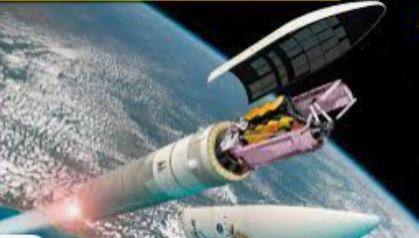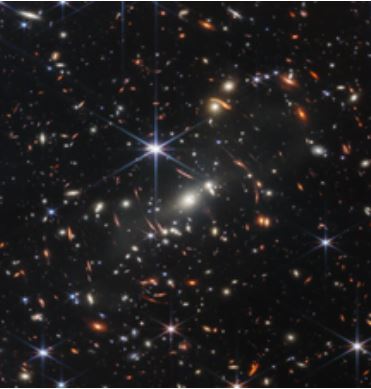Table of Contents
JAMES WEBB SPACE TELESCOPE
Introduction of JWST
The James Webb Space Telescope (JWST) is a space telescope primarily designed for infrared astronomy. As the most powerful telescope ever launched into space, its greatly improved infrared resolution and sensitivity will allow it to see objects that the Hubble Space Telescope cannot see because they are too old, distant, or faint. This is expected to enable a wide range of astronomical and cosmological investigations, such as observations of first stars and the formation of first galaxies, as well as detailed atmospheric characterisation of potentially habitable exoplanets.

When JWST Launched.
JWST was launched from Kourou, French Guiana, on a European Space Agency (ESA) Ariane 5 rocket in December 2021 and entered orbit in January 2022. JWST is expected to succeed Hubble as NASA’s flagship astrophysics mission in July 2022. On July 11, 2022, NASA released the first image from JWST, the Universe’s oldest and highest resolution image.

Agencies responsible for development of JWST.
JWST was developed by NASA in collaboration with ESA and the Canadian Space Agency (CSA). The NASA Goddard Space Flight Center (GSFC) in Maryland oversaw telescope development, the Space Telescope Science Institute in Baltimore operates JWST, and Northrop Grumman was the prime contractor. The telescope is named after NASA Administrator James E. Webb, who served from 1961 to 1968 during the Mercury, Gemini, and Apollo programmes.
JWST Launched.
Development began in 1996 with a $500 million budget and an initial launch date of 2007. Many delays and cost overruns occurred, including a major redesign in 2005, a ripped sunshield during a practise deployment, recommendations from an independent review board, a threat to cancel the project by the United States Congress, the COVID-19 pandemic, and problems with the telescope itself. The media, scientists, and engineers all commented on the launch’s high stakes and the telescope’s complexity. Construction was completed in late 2016, and years of extensive testing preceded the launch. The total cost of the project is now expected to be around $9.7 billion.
Physical parameters of JWST.
JWST’s primary mirror is made up of 18 hexagonal mirror segments made of gold-plated beryllium that come together to form a 6.5-meter (21-foot) diameter mirror, compared to Hubble’s 2.4 m. (7.9 ft). This gives the Webb telescope a light-collecting area of about 25 square metres, which is approximately six times that of Hubble. JWST will observe in a lower frequency range, from long-wavelength visible light (red) to mid-infrared (0.6-28.3 m), as opposed to Hubble, which observes in the near ultraviolet, visible, and near infrared (0.1-1.7 m) spectra. To observe faint signals in the infrared spectrum without interference from other sources of thermal energy, the telescope must be kept extremely cold, below 50 K (223 °C; 370 °F). It’s in a solar orbit near the Sun-Earth L2 Lagrange point, about 1.5 million kilometres (930,000 miles) from Earth, where its five-layer, kite-shaped sunshield protects it from the Sun, Earth, and Moon’s heat.
Features of JWST.
The mass of the James Webb Space Telescope is roughly half that of the Hubble Space Telescope. The JWST’s primary mirror is 6.5 metres (21 feet) in diameter and is made up of 18 separate hexagonal mirrors. The polished area of the mirror is 26.3 m2 (283 sq ft), with the secondary support struts obscuring 0.9 m2 (9.7 sq ft), for a total collecting area of 25.4 m2 (273 sq ft). This is more than six times larger than Hubble’s 2.4-meter (7.9-foot) diameter mirror, which has a collecting area of 4.0 m2 (43 sq ft). The mirror is gold-coated for infrared reflectivity and durability.
JWST is primarily intended for near-infrared astronomy, but depending on the instrument, it can also see orange and red visible light, as well as the mid-infrared region. It can detect objects up to 100 times fainter than Hubble and objects from much earlier in the universe’s history.
JWST can also observe objects in the vicinity, including those in the Solar System, with apparent angular rates of motion of 0.030 arc seconds per second or less. This includes all planets and satellites beyond Earth’s orbit, as well as “virtually all” known Kuiper Belt Objects. Furthermore, it can observe opportunistic and unplanned targets, such as supernovae and gamma ray bursts, within 48 hours of a decision to do so.
Orbit and location Of JWST.
JWST is in a halo orbit, circling the Sun-Earth L2 Lagrange point in space, which is approximately 1,500,000 km (930,000 mi) beyond Earth’s orbit around the Sun. Its actual position varies between 250,000 and 832,000 km (155,000-517,000 mi) from L2 as it orbits, keeping it out of the shadows of both the Earth and the Moon. In comparison, Hubble orbits 550 km (340 mi) above Earth’s surface, and the Moon is approximately 400,000 km (250,000 mi) away. Objects near this Sun-Earth L2 point can orbit the Sun in synchrony with the Earth, allowing the telescope to maintain a roughly constant distance with its unique sunshield and equipment bus continuously oriented toward the Sun, Earth, and Moon Combined.
NASA’S James Webb Space Telescope reveals the universe as we’ve never seen it before.
Today, NASA’s $10 billion new telescope revealed a remarkable image of some of the universe’s very first galaxies.
At first glance, the first image from NASA’s new James Webb Space Telescope may not appear to be particularly noteworthy.What appear to be tiny specks in space are, in fact, galaxies billions of years old.
“If you held a grain of sand at arms length, that’s the part of the universe you’re seeing — just one little speck of the universe,” NASA Administrator Bill Nelson said of the image on Monday.
Furthermore, this image captures some of the very first galaxies to form in the universe. More images from the James Webb Space Telescope should reveal which galaxies in the far, far distance are habitable, according to Nelson.
The White House and NASA released the first image from the telescope since its launch from Earth more than six months ago.

NASA had planned to release the image today as part of a collection of the first scientific results, but decided that the image is so dramatic that it should be revealed to the world by Biden.
The James Webb Space Telescope, which cost $10 billion, is the most sophisticated observatory ever launched. It left Earth in December of last year. It arrived at its celestial parking spot a million miles away from Earth in late January. Since then, engineers have been testing the instruments, aligning the mirrors, and allowing the telescope to cool down so that the instruments can function properly.
“Webb was built to find the first generation of galaxies that formed after the big bang,” says Jane Rigby, the telescope’s operations project scientist. “That is the primary scientific goal for which it was designed.”


